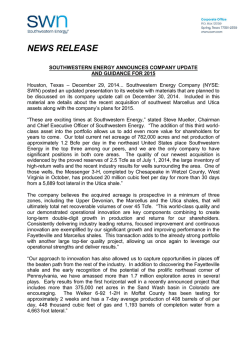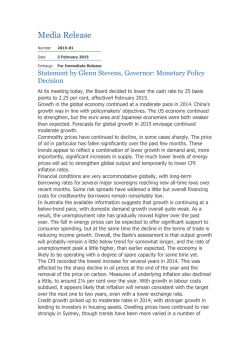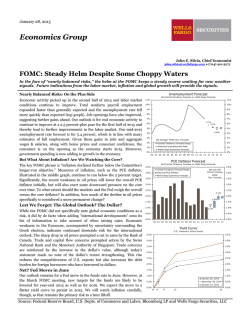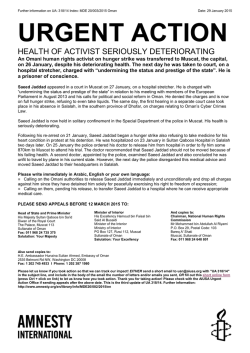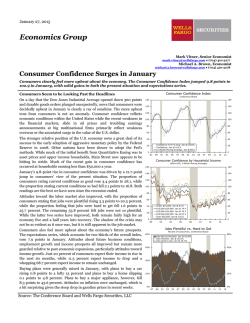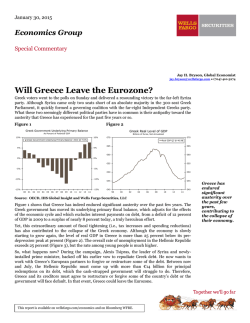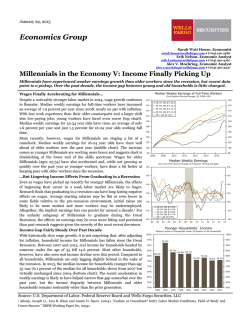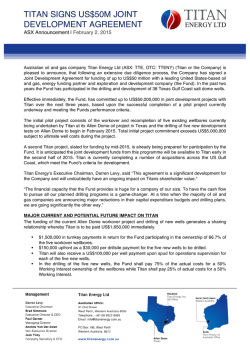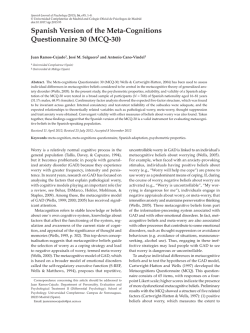
P.20 - Oman Tribune
BUSINESS 20 US deficit to dip to $468b, will be lowest since ’07 WASHINGTON THE US BUDGET DEFIcit will decline slightly to $468 billion this fiscal year, the lowest level since President Barack Obama took office, congressional forecasters said on Monday in a report heralding the end of a brief period of dramatically shrinking red ink. The deficit, down from the $1 trillion-plus levels of Obama’s first four years and a $483 billion gap in fiscal 2014, will stay largely flat in NARROWING GAP As a share of the economy, the deficit will be the lowest since 2007 and close to the average over the past 50 years 2016, then begin to march upward due to rising costs for debt and caring for fastretiring Baby Boomers. Estimates by the Congressional Budget Office kick off what promises to be a contentious budget debate in Washington. Republicans now in control of Congress seek to eliminate deficits within 10 years with cuts to social safety net programmes while lowering tax rates and boosting military spending. Obama and his Democrats have proposed new education and infrastructure spending and tax breaks for middle-class Americans to set the agenda for the 2016 presidential election. Obama will present his fiscal 2016 budget plan on Feb. 2. “CBO’s longer-term budget and economic projections confirm the need for Congress to act to strengthen our economy for the middle class while putting our debt P.CLOSE CLOSE NET Rising costs force firms to shut older wells; further oil slide to cut 2% of supply HOUSTON and deficits on a sustainable trajectory,” White House Deputy Press Secretary Eric Schultz said. The CBO report shows the respite in deficits, fueled by a recovering economy, will be short-lived as the federal debt continues to grow. “If nothing is done, we will continue down an unsustainable path full of rising annual deficits that will add to an already $18 trillion debt,” said Republican House Budget Committee Chairman Tom Price. “Our vital health and retirement programs will continue to grow further toward insolvency.” A major pressure point for Republican demands to slash spending will come in mid-March, when an extension of the federal debt limit expires. But the CBO estimated that if Congress fails to grant an extension, the Treasury Department could stave off a default crisis until September or October by employing extraordinary cash management measures. Relative to the size of the US economy, the federal deficit after 2018 will be back above its 50-year average of 2.7 per cent of gross domestic product. The CBO said higher interest rates will nearly quadruple debt payments to $827 billion in 2025. The non-partisan agency also said real economic growth would be modest, peaking at 3 per cent in 2016, then slowing as Baby Boomers retire. As a share of the economy, the deficit will be the lowest since 2007 and close to the average over the past 50 years. The 2.6 per cent prediction for this year compares with a deficit of 9.8 per cent in 2009. Annual deficits will one again surpass the $1 trillionmark by 2025, however, because of the cost of servicing the nation al debt and paying for retiring baby boomers, confirming that the country’s longer-term fiscal problems are unsolved. COLLAPSING CRUDE prices are confronting scores of smaller US oil producers with the grim choice of either shutting older high-cost wells or burning through cash in the hope of riding out the downturn. As oil prices fell by more than half over the last six months from more than $100 per barrel, the US oil industry responded by slowing its blistering growth and dialing back expansion plans. Now, with US crude around $46 a barrel, operators are already closing some small old wells, known as strippers, and tens of thousands of similar wells are on the verge of losing money. A further slide could, by some estimates, idle an equivalent of up to 2 per cent of US supply, slowing overall output growth more than expected or even leaving it flat. Ray Lasseigne, an oilfield veteran and president of TMR Exploration in Louisiana, is deciding which wells to close. TMR looks to close old wells, which produce so much saltwater that disposal costs exceed what the oil can fetch today. Other running costs include repairs and electricity to run the pump jacks, also known as nodding donkeys because they bob up and down while pulling oil out of the ground. “We’ve identified about 20 of our wells that are not economic at these prices,” said Lasseigne. That figure represents about 10 per cent of the Bossier City, Louisiana company’s wells, he said. His most expensive stripper wells need oil around $70 to be profitable. Leslie Tipping, a longtime member of the oil industry profession known as “landmen” who broker mineral rights, said some marginal wells have already been closed. “There have been some wells that have been shut in already,” she said. Tipping, who manages oil and gas interests for patrons of the bank Northern Trust in Agencies TURNOVER TRADES VOLUME VOLUME PRICE VOLUME File An oil pump jack in Watford City, North Dakota. With US crude around $46 a barrel, operators are already closing some small old wells and tens of thousands of similar wells are on the verge of losing money. Texas, said she was fielding more calls from clients who are nervously watching sliding crude prices. “Most of our clients have inherited these assets, so they’ve been through this before,” said Tipping. “But there’s concern. There’s some fear.” She expects well closures at higher-cost fields across much of North America, including older parts of North Dakota’s Bakken, and areas where the geology is difficult, such as the Anadarko Basin in Kansas and Oklahoma. There are about 400,000 stripper wells in the US, most with operating costs of between $20 and $50 per barrel, according to analysts at Wood Mackenzie, a leading energy and commodities consultancy. The cheapest ones are in locations where there is BEST ASK PRICE BEST BID LOW HIGH OPEN TOP COMPANY REGULAR MARKET FINANCIAL SECTOR AL ANWAR HOLD .. (AAIT) AHLI BANK (ABOB) AL MADINA INV .. (AMII) BANK DHOFAR (BKDB) BANK MUSCAT (BKMB) BANK SOHAR (BKSB) GLOBAL FINANC .. (GFIC) GULF INVESTME .. (GISI) HSBC BANK OMA .. (HBMO) NATIONAL BANK .. (NBOB) OMAN AND EMIR .. (OEIO) OMINVEST (OMVS) ONIC. HOLDING (ONIC) OMAN UNITED I .. (OUIS) AL SHARQIA IN .. (SIHC) TAAGEER FINAN .. (TFCI) Total little underground saltwater. Strippers often produce just a few barrels a day, but together they account for up to 1 million barrels per day, a ninth of US output. Not all stripper wells are losing money now and those that do may not be shut in. This is in part because producers can lose their leases forever if they shut wells for more than a few months, so owners are often willing to pump at a loss and store oil until prices rise. “At $40, we think you have got about 100,000 to 200,000 barrels per day at risk” from US stripper wells, said RT Dukes of Wood Mackenzie. That could represent a dent of up to 2 per cent dent in output compared with US Energy Information Agency forecasts that this year’s US 0.350 0.612 0.113 0.430 0.388 0.322 0.149 0.227 0.229 0.071 37,804 0.594 0.230 40,000 0.148 0.143 0.344 0.125 5,000 12,154 150,000 0.182 274,459 1,560 15,000 18,400 0.360 17,000 4,220 0.114 65,420 8,955 6,000 58,000 0.444 0.392 0.324 83,597 0.151 0.228 0.239 0.073 1,000 0.596 0.231 42,326 0.149 0.144 0.350 0.126 3,000 5,000 7,350 0.184 3,384 14,500 733 14,000 3 116,701 10,000 7 35,500 2,700 132,129 3,400 2 13 26 39,860 1 100 1,484,923 337,626 48 840,100 195,087 34 274,049 19,576 15,696 5,494 0.350 97 1,424,199 856,467 27 859,154 197,430 162,674 18,545 41 977,230 146,850 4 46,045 6,609 11 115,000 40,850 50 632,350 80,421 10,000 4,300 0.430 162,846 63,184 293,500 96,086 134 1,439,871 259,099 2,765 412 0.149 598 8,740,402 2,328,035 0.229 0.230 0.070 0.350 0.612 0.230 0.114 0.152 0.143 0.360 0.130 0.430 0.388 0.330 0.175 0.150 0.227 0.232 0.071 0.350 0.600 0.230 0.114 0.150 0.144 0.356 0.127 0.430 0.388 0.328 0.180 0.150 0.229 0.237 0.075 0.350 0.612 0.233 0.114 0.152 0.146 0.360 0.130 0.430 0.388 0.328 0.172 0.149 0.229 0.235 0.075 0.350 0.612 0.230 0.114 0.152 0.144 0.360 0.131 0.430 0.388 0.330 0.184 0.149 0.226 0.230 0.068 0.596 0.229 0.114 0.148 0.143 0.350 0.125 0.388 0.324 0.175 production will average 9.3 million bpd. After production hit 9.1 million bpd in late 2014, the agency now expects production to climb to 9.42 million bpd around the middle of this year, then ebb to 9.26 million bpd at year’s end. Its latest January 13 outlook forecasts the 2015 average price of the Brent crude global benchmark at $58 a barrel and the U.S. benchmark at $3-4 below that. Some warn the slowdown could be more pronounced given the sharp drop in the number of rigs drilling new wells. The prevailing industry view, however, is that new, more productive, shale oil wells in Texas, North Dakota and Colorado will keep output rising. Those wells, which typically do not need constant pumping to make oil flow, have helped US crude output to nearly double since 2007. They have also prompted Opec and Saudi Arabia to let prices fall in what is widely seen as an attempt to force US rivals to cut output. But publicly-traded shale oil companies talk of cash operating costs between $10 and $30 a barrel, suggesting oil prices would have to fall by another third to force them consider well closures. The upshot? It might take a prolonged slowdown in drilling of new wells to significantly curb US supply. Break even levels for drilling new wells in most US shale oil fields range between $50 and $80 per barrel - well above operating costs for existing shale wells. In response to the price slump, most oil companies have already cut drilling budgets by 25 per cent or more, but they are still sinking new wells. Furthermore, unlike small stripper well operators, several producers have hedged much of their 2015 output at prices close to $90 a barrel, keeping lots of their new output profitable. Vast efficiency gains also mean that more oil can be squeezed from fewer new wells. For example, EOG Resources said in November that output of new fracked wells in the Eagle Ford shale of Texas was up 39 per cent compared with wells sunk at the start of 2014. “To me, it’s going to be extremely difficult for any US production to be cut significantly,” TMR’s Lasseigne said about the possible impact of well closures. Reuters BP freezes pay in 2015 to cut costs LONDON 0.2270.002 (0.87%) 0.2300.005 (2.11%) 0.0710.004 (5.33%) 0.3500 (0%) 0.5960.012 (1.96%) 0.2300.003 (1.29%) 0.1140 (0%) 0.1490.002 (1.32%) 0.1440.002 (1.37%) 0.3500.004 (1.11%) 0.1260.003 (2.31%) 0.4300 (0%) 0.3880 (0%) 0.3240 (0%) 0.1830.008 (4.65%) 0.1490 (0%) WEDNESDAY, JANUARY 28, 2015 Oil rout roils small US producers MUSCAT SECURITIES MARKET LAST OMAN TRIBUNE BP IS FREEZING BASE pay across the group this year, the latest in a series of steps by oil majors to cut costs in response to sinking oil prices. Over the past year, oil majors have been selling assets to protect cash flows and shareholder dividends. Many have accelerated cuts in capital and operating expenditures, including freezing some projects, as crude prices more than halved since June to below $50 per barrel. Salaries in the oil sector are a major part of operating expenses. BP employed 83,900 employees in 2013 and paid them around $13.6 billion in benefits, including wages and pensions, according to the company’s website. “The tougher external environment in 2015 means that our businesses and functions need to work... to take a number of measures in response to the harsh trading environment,” chief executive Bob Dudley said. “One of the measures we are taking across the group is a general freeze to base pay for 2015, with only a few exceptions for specific circumstances around the world,” Dudley added. A BP spokesman would not comment directly on the internal message but confirmed the step, saying: “We have told staff across BP that we intend to freeze base pay worldwide for 2015. “Together with our work to simplify and increase efficiency across BP, we see this as a prudent measure in response to the current challenging market environment in which BP is operating.” In December, BP announced a $1 billion programme to cut thousands of jobs globally, including its UK North Sea operations. Agencies INDUSTRIAL SECTOR AL ANWAR CER .. (AACT) AL JAZEERA ST .. (ATMI) DHOFAR CATTLE .. (DCFI) GALFAR ENGINE .. (GECS) GULF INTERNAT .. (GICI) OMAN CABLES I .. (OCAI) OMAN CEMENT (OCOI) OMAN FLOUR MI .. (OFMI) RAYSUT CEMENT (RCCI) SALALAH MILLS (SFMI) VOLTAMP ENERG .. (VOES) Total 0.4480.002 (0.44%) 0.3300 (0%) 0.1800 (0%) 0.1800 (0%) 0.1900 (0%) 2.0100 (0%) 0.4700.012 (2.3%) 0.5800.004 (0.68%) 1.8550 (0%) 1.4850 (0%) 0.3900.008 (2.09%) 0.444 5,000 5,000 2,500 30,000 1,500 0.470 0.578 1.855 146 0.000 0 0.386 10,000 0.330 0.193 0.182 0.190 2.020 9,467 900 1.870 1.485 2,500 0.448 3,000 6,000 35,000 13,200 3,661 0.514 0.580 500 4,935 0.394 150 6 5 16 3 3 5,395 1,400 3 1 10,000 3 6,850 32,000 10,530 110,000 149,500 10,000 1,900 3,500 7,048 5 7,738 3 7,800 5,873 10,894 65 97 4 8,942 52 342,268 3,069 0.328 19,800 27,144 0.190 2.010 3,953 4,526 1.855 1.485 3,487 92,448 0.448 0.330 0.180 0.182 0.190 2.010 0.516 0.582 1.855 1.485 0.390 0.448 0.330 0.180 0.182 0.190 2.010 0.510 0.580 1.855 1.485 0.390 0.450 0.330 0.180 0.182 0.190 2.020 0.522 0.584 1.855 1.485 0.382 0.448 0.328 0.180 0.183 0.190 2.010 0.516 0.582 1.855 1.485 0.390 0.3380 (0%) 0.5660 (0%) 0.2360 (0%) 2.2000 (0%) 0.6960 (0%) 1.7750.005 (0.28%) 0.3240.032 (8.99%) 0.4820.018 (3.6%) 1.7200 (0%) 0.334 0.566 0.235 2.200 0.696 0.338 0.596 0.236 2.230 0.700 417 3,000 10,000 1.800 18,717 18,500 20,000 1,000 72,705 1.780 0.330 0.482 500 23 2 14 1 20 86,680 3,000 3,400 1 233,923 1,050 625 211,000 300 660 169,479 66 173,254 10 43,000 7 34,100 42 72 144 866,148 79,240 0.598 50,572 2.200 118,417 309,071 13,956 16,440 1.720 589,054 0.340 0.596 0.242 2.220 0.700 1.795 0.324 0.484 1.655 0.338 0.596 0.240 2.220 0.700 1.785 0.324 0.482 1.655 0.338 0.598 0.240 2.200 0.700 1.790 0.356 0.500 1.720 0.340 0.566 0.242 2.200 0.700 1.795 0.328 0.484 1.720 0.0900.001 (1.1%) 0.0950 (0%) 0.0810 (0%) 0.1950.004 (2.01%) 0.090 42,211 0.092 25,000 0.094 0.080 248,130 0.081 0.194 15,000 0.092 5,000 17,870 0.195 5,000 1 3 5,985 13 78,400 3,565 339 21,130 1,712 24 240,887 41 343,982 7,091 0.095 0.081 47,054 56,194 0.091 0.092 0.081 0.199 0.090 0.092 0.081 0.195 0.091 0.095 0.081 0.199 0.091 0.095 0.081 0.199 0.5820 (0%) 0.1020.005 (4.67%) 0.2440 (0%) 0.0690.002 (2.99%) 0.580 8,072 0.102 0.244 900 0.068 0.582 166,593 0.258 7,400 855 0.104 15,000 0.070 16 5,000 1 4,590 76,783 44,949 46 640,784 100 24 2 7,200 65 724,867 0.586 65,616 0.244 497 111,086 0.586 0.100 0.244 0.069 0.586 0.102 0.244 0.069 0.588 0.107 0.244 0.067 0.582 0.105 0.244 0.069 0.1790.001 (0.56%) 3.2000.05 (1.59%) 2.2550 (0%) 0.1790.002 (1.12%) 0.179 0.179 3.200 2.260 500 0.179 50,807 848 2.300 36,503 0.180 3.300 1,000 0.180 191,972 344 2 75,209 36 8 2,481 36 82 46,363 37,368 2.255 32,428 121,755 0.179 3.180 2.255 0.179 0.179 3.200 2.255 0.180 0.178 3.150 2.255 0.178 0.180 3.200 2.255 0.180 0.0600 (0%) 0.06 0.000 0 0.000 0 1 50,000 3,000 1 50,000 0.060 3,000 0.060 0.060 0.060 0.060 0.1050 (0%) 0.1020 (0%) 0.1060 (0%) 0.105 140,028 0.000 0.092 10,000 0.000 0.106 200,000 0.108 1,492 325 134 4 157 33 14 1,951 0.105 0.102 0.106 204 0.107 0.102 0.106 0.107 0.102 0.106 0.105 0.105 0.102 0.102 0.106 0.106 987 11,523,488 0.326 0.175 0.180 0.189 2.010 0.448 0.180 0.180 0.470 0.580 0.390 SERVICES SECTOR AL JAZEERA SE .. (AJSS) NATIONAL GAS (NGCI) OMAN INVESTME .. (OIFC) OMAN OIL MARK .. (OOMS) OOREDOO (ORDS) OMAN TELECOMM .. (OTEL) PORT SERVICES .. (PSCS) RENAISSANCE S .. (RNSS) UNITED POWER (UECS) Total 7,500 2,100 10,000 5,200 1,221 1.775 0.322 0.480 1.725 625 0.338 0.236 0.696 1.775 0.324 0.482 PARALLEL MARKET FINANCIAL SECTOR AL MADINA TAK .. (AMAT) ALIZZ ISLAMIC .. (BKIZ) BANK NIZWA (BKNZ) AL BATINAH DE .. (DBIH) Total 0.090 0.195 INDUSTRIAL SECTOR ALMAHA CERAMI .. (AMCI) AL HASSAN ENG .. (HECI) MAJAN GLASS (MGCI) OMAN FISHERIE .. (OFCI) Total 0.100 0.069 SERVICES SECTOR AL BATINAH PO .. (BATP) SHARQIYAH DES .. (SHRQ) SEMBCORP SALA .. (SSPW) AL SUWADI POW .. (SUWP) Total 259,067 11,681 5,595 180,641 453,870 THIRD MARKET INDUSTRIAL SECTOR NATIONAL MINE .. (NMWI) Total Bonds Market Bonds BANK MUSCAT C .. (BMBC) BANK SOHAR BO .. (BSCB) BANK MUSCAT C .. (MCCB) Total MARKET SUMMARY 0 2 0 1 119,347 1 3,301,776 0.178 3.180 0.179 Foxconn to cut jobs on weak sales SHENZHEN TAIWAN’S FOXCONN Technology Group, the world’s largest contract electronics manufacturer, will cut its massive workforce, the company said, as the Apple Inc supplier faces declining revenue growth and rising wages in China. Under its flagship unit Hon Hai Precision Industry, the group currently employs about 1.3 million people during peak production times, making it one of the largest private employers in the world. Special assistant to the chairman and group spokesman Louis Woo did not specify a timeframe or target for the reduction, but noted that labour costs had more than doubled since 2010, when the company faced intense media scrutiny following a spate of worker suicides. “We’ve basically stabilised (our workforce) in the last three years,” Woo said. When asked if the company plans to reduce overall headcount, he responded “yes”. Revenue growth at the conglomerate tumbled to 1.3 per cent in 2013 and only partially recovered to 6.5 per cent last year after a long string of double-digit increases from 2003 to 2012. That decade saw the firm ride an explosion of popular- File Workers look on from a Foxconn logo near the gate of the company’s factory in the township of Longhua, Guangdong province. Foxconn will cut its massive workforce. ity in PCs, smartphones and tablets, largely driven by its main client Apple, but now it will halve this year from 26 per cent in 2014, according to researcher IDC, while PC sales Revenue growth at the conglomerate tumbled to 1.3 per cent in 2013 is feeling the effects of falling growth and prices in the gadget markets it supplies, a trend that is expected to continue. Growth in smartphone sales will contract by 3 per cent. Similarly, the average smartphone will sell for 19 per cent less in 2018 than last year’s $297. “Even if technology is improving, the price will still come down,” Woo said. “We’ve come to accept that, our customers have come to accept that.” Automation will be key to keeping labour costs under control in the long-term, Woo said, as the company pushes to have robotic arms complete mundane tasks currently done by workers. But Woo noted that company chairman Terry Gou’s previously stated goal of 1 million robots was “a generic concept” rather than a firm target. Agencies
© Copyright 2026

